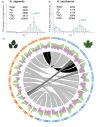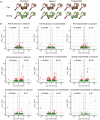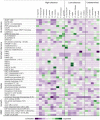Strategies of tolerance reflected in two North American maple genomes
- PMID: 34967059
- PMCID: PMC9304320
- DOI: 10.1111/tpj.15657
Strategies of tolerance reflected in two North American maple genomes
Abstract
The first chromosome‐scale assemblies for North American members of the Acer genus, sugar maple (Acer saccharum) and boxelder (Acer negundo), as well as transcriptomic evaluation of the abiotic stress response in A. saccharum are reported. This integrated study describes in‐depth aspects contributing to each species' approach to tolerance and applies current knowledge in many areas of plant genome biology with Acer physiology to help convey the genomic complexities underlying tolerance in broadleaf tree species.
Maples (the genus Acer) represent important and beloved forest, urban, and ornamental trees distributed throughout the Northern hemisphere. They exist in a diverse array of native ranges and distributions, across spectrums of tolerance or decline, and have varying levels of susceptibility to biotic and abiotic stress. Among Acer species, several stand out in their importance to economic interest. Here we report the first two chromosome-scale genomes for North American species, Acer negundo and Acer saccharum. Both assembled genomes contain scaffolds corresponding to 13 chromosomes, with A. negundo at a length of 442 Mb, an N50 of 32 Mb, and 30 491 genes, and A. saccharum at a length of 626 Mb, an N50 of 46 Mb, and 40 074 genes. No recent whole genome duplications were detected, though A. saccharum has local gene duplication and more recent bursts of transposable elements, as well as a large-scale translocation between two chromosomes. Genomic comparison revealed that A. negundo has a smaller genome with recent gene family evolution that is predominantly contracted and expansions that are potentially related to invasive tendencies and tolerance to abiotic stress. Examination of RNA sequencing data obtained from A. saccharum given long-term aluminum and calcium soil treatments at the Hubbard Brook Experimental Forest provided insights into genes involved in the aluminum stress response at the systemic level, as well as signs of compromised processes upon calcium deficiency, a condition contributing to maple decline.
Keywords: Acer negundo; Acer saccharum; abiotic stress; aluminum; calcium; differential expression; genome; nutrient stress; plasticity; tolerance.
Conflict of interest statement
The authors declare no conflicts of interest.
Figures







Similar articles
-
Development of novel genic microsatellite markers from transcriptome sequencing in sugar maple (Acer saccharum Marsh.).BMC Res Notes. 2017 Aug 8;10(1):369. doi: 10.1186/s13104-017-2653-2. BMC Res Notes. 2017. PMID: 28789702 Free PMC article.
-
Calcium and aluminum impacts on sugar maple physiology in a northern hardwood forest.Tree Physiol. 2013 Nov;33(11):1242-51. doi: 10.1093/treephys/tpt099. Tree Physiol. 2013. PMID: 24300338
-
Molecular analysis of red maple (Acer rubrum) populations from a reclaimed mining region in Northern Ontario (Canada): soil metal accumulation and translocation in plants.Ecotoxicology. 2015 Apr;24(3):636-47. doi: 10.1007/s10646-014-1411-7. Epub 2015 Jan 6. Ecotoxicology. 2015. PMID: 25560741
-
Norway maple displays greater seasonal growth and phenotypic plasticity to light than native sugar maple.Tree Physiol. 2012 Nov;32(11):1339-47. doi: 10.1093/treephys/tps092. Epub 2012 Oct 16. Tree Physiol. 2012. PMID: 23076822
-
Base cation stimulation of mycorrhization and photosynthesis of sugar maple on acid soils are coupled by foliar nutrient dynamics.New Phytol. 2005 Feb;165(2):581-90. doi: 10.1111/j.1469-8137.2004.01249.x. New Phytol. 2005. PMID: 15720668
Cited by
-
Leaf gene expression trajectories during the growing season are consistent between sites and years in American beech.Proc Biol Sci. 2024 Apr 10;291(2020):20232338. doi: 10.1098/rspb.2023.2338. Epub 2024 Apr 10. Proc Biol Sci. 2024. PMID: 38593851 Free PMC article.
-
Chromosome-Level Genome Assembly for Acer pseudosieboldianum and Highlights to Mechanisms for Leaf Color and Shape Change.Front Plant Sci. 2022 Mar 3;13:850054. doi: 10.3389/fpls.2022.850054. eCollection 2022. Front Plant Sci. 2022. PMID: 35310631 Free PMC article.
-
Transcriptome profiling, physiological, and biochemical analyses provide new insights towards drought stress response in sugar maple (Acer saccharum Marshall) saplings.Front Plant Sci. 2023 Apr 19;14:1150204. doi: 10.3389/fpls.2023.1150204. eCollection 2023. Front Plant Sci. 2023. PMID: 37152134 Free PMC article.
-
Profiling genome-wide methylation in two maples: Fine-scale approaches to detection with nanopore technology.Evol Appl. 2024 Apr 17;17(4):e13669. doi: 10.1111/eva.13669. eCollection 2024 Apr. Evol Appl. 2024. PMID: 38633133 Free PMC article.
-
High-resolution genome assembly and population genetic study of the endangered maple Acer pentaphyllum (Sapindaceae): implications for conservation strategies.Hortic Res. 2024 Dec 17;12(4):uhae357. doi: 10.1093/hr/uhae357. eCollection 2025 Apr. Hortic Res. 2024. PMID: 40066161 Free PMC article.
References
-
- Bal, T.L. , Storer, A.J. , Jurgensen, M.F. , Doskey, P.V. & Amacher, M.C. (2015) Nutrient stress predisposes and contributes to sugar maple dieback across its northern range: a review. Forestry: An International Journal of Forest Research, 88, 64–83. 10.1093/forestry/cpu051. - DOI
-
- Begum, H.H. , Osaki, M. , Watanabe, T. & Shinano, T. (2009) Mechanisms of aluminum tolerance in phosphoenolpyruvate carboxylase transgenic rice. Journal of Plant Nutrition, 32(1), 84–96.
-
- Berger, T.W. , Eagar, C. , Likens, G.E. & Stingeder, G. (2001) Effects of calcium and aluminum chloride additions on foliar and throughfall chemistry in sugar maples. Forest Ecology and Management, 149(1), 75–90. Available from: 10.1016/S0378-1127(00)00546-6 - DOI
-
- Bishop, D.A. , Beier, C.M. , Pederson, N. , Lawrence, G.B. , Stella, J.C. & Sullivan, T.J. (2015) Regional growth decline of sugar maple (Acer saccharum) and its potential causes. Ecosphere, 6(10), art179. Available from: 10.1890/ES15-00260.1 - DOI
Publication types
MeSH terms
Substances
LinkOut - more resources
Full Text Sources

